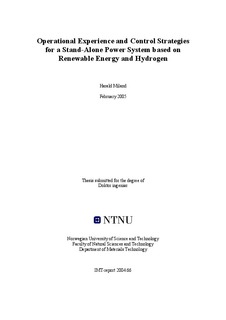| dc.description.abstract | The topic of this thesis is investigation of a small-scale stand-alone power system, based on both experimental work and computer simulations. The power system in this study uses solar energy as energy input, lead-acid batteries as short-term energy storage, and hydrogen as long-term energy storage. The main focus is upon operation and control of the hydrogen subsystem, as a robust controller is needed in order to prevent excessive use of the components in this subsystem. The laboratory power system comprises of: Hydrogen subsystem (PEM electrolyser, metal hydride, and PEM fuel cell), a lead-acid battery, programmable power supply for emulation of PV arrays, wind turbines, and controlled characterisation of the individual system components, and a programmable electronic load.
The intention was to build the laboratory power system as simple and energy efficient as possible. The components were connected directly in parallel on a common 48 V DC bus bar, no power electronics were applied between the components. Furthermore, the metal hydride and the fuel cell were air-cooled, avoiding auxiliaries required for water- cooling. The electrolyser, however, needed water-cooling. But with the electrolyser delivering hydrogen at 16 bars to a low pressure metal hydride, no use of compressor was required. On the other hand, metal hydrides needs purified hydrogen gas, > 99.999 %, in order to maintain its capacity as specified by the manufacturer.
The actual work in this thesis is divided in three main parts:
1. Design, construction, and operation of a laboratory hydrogen power system
2. Establishment of a computer model of the laboratory hydrogen power system, which interpolates and extrapolates its outputs based on experimental data collected from the laboratory system
3. Establishment of control algorithms for high-level energy management of the laboratory hydrogen power system based on the developed computer model. It is a goal to make the implementation and maintenance of these control algorithms as simple as possible. Furthermore, the control algorithms must enable efficient usage of the system components and secure energy supply to the end user
The results of this thesis are divided in two main parts:
The first part of the main results relates to the proposal and development of two types of control algorithms for high-level energy management, which will be denoted as the Control Matrix and the Fuzzy controller in the thesis. These control algorithms are suggested as opposed to the more traditional battery five-step charge controller. Identification of important system parameters and choosing proper settings for control parameters must be implemented into the control algorithms in order to finalise a complete control strategy. It will be shown that the electrolyser annual runtime decreases while the electrolyser annual hydrogen production remains the same by using the proposed control strategies, thus running the electrolyser more efficient.
Furthermore, with a reduction in the total number of electrolyser start-ups, a more stable system operation is achieved.
The second part of the main results relates to the operational experience of the small-scale laboratory hydrogen power system. Due to the amount of power required by the local control system integrated into the fuel cell and the electrolyser, the energy efficiency of the fuel cell and the electrolyser is lower at partial loads. Thus, with the additional energy needed for hydrogen purification, the round-trip efficiency of the hydrogen subsystem is found to be rather low (< 30 %), when the fuel cell and the electrolyser runs at low partial loads. However, it is encouraging that the hydrogen subsystem can reach 35 – 40 % when the fuel cell and the electrolyser are allowed to run at nominal power levels, in addition to optimal arrangement of the hydrogen purification unit. These energy efficiencies are higher than efficiencies achieved with diesel-fuelled generators. Besides, stand-alone power systems often resides in remote areas where transportation of diesel is costly, thus local production of the fuel by means of electrolyser and excess renewable energy can be profitable.
Regarding the difficulty of measuring the true amount of hydrogen present in the metal hydride, and because this system parameter is important in the control strategy, a pressurised vessel is recommended instead of the air-cooled metal hydride. Furthermore, it is recommended to use DC/DC converters in the hydrogen power system in order to ensure power quality within specifications and robust operation. | nb_NO |
